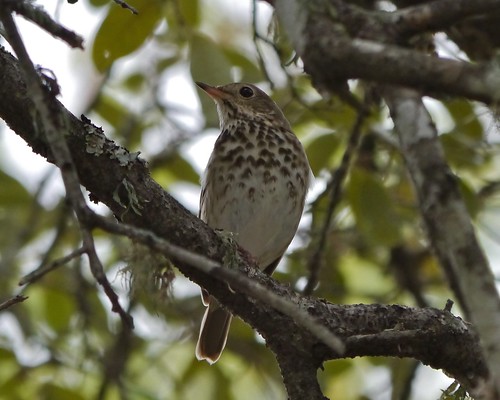This morning I spent about two hours birding on the streets near my house. I haven't done this in quite a while. Lately I've been doing most of my neighborhood birding on our hike-and-bike trail. The trail has the most habitat types and is the best bet for finding the most bird species, but there are a few kinds of birds that are easier to find in the trees among our houses. We're lucky to have lots of mature native trees here that are often close enough together to form a forest canopy. Many songbird species prefer this forest canopy habitat and one that I was excited to find this morning is Brown Creeper. I found one on Newberry Drive this morning and got this photo.
Brown Creepers are small brown birds that forage for insects in the bark of tree trunks and thick branches instead of among the leaves and twigs like most insectivorous songbirds. So they "creep" up and down tree trunks like a woodpecker. But instead of hammering and prying into the bark like woodpeckers, they have delicate slightly curved bills that they just use to probe existing crevices. Brown Creepers are only here in the winter, and I usually only see them a handful of times each season. But local birders are finding more of them in central Texas than usual, so keep your eyes open for one!
Some other species I found in our forest canopy habitat this morning were year-round residents like Carolina Chickadee, Black-crested Titmouse, Red-bellied Woodpecker, Downy Woodpecker, and winter species like Ruby-crowned Kinglet, Orange-crowned Warbler, Northern Flicker, and Yellow-rumped Warbler.
A habitat type that is much less common on the streets near my house is low, dense brush and tall grass. Most people consider this habitat type messy or ugly, so they keep grass trimmed short, and bushes and shrubs limited and neatly trimmed. Many species of songbirds prefer this type of habitat and therefore usually cannot be found near our houses. (We're lucky to have lots of this habitat type on our hike-and-bike trail, adding greatly to the diversity of birds that can be found there.) But this morning I was excited to find a two of these bird species in just a few tucked away patches of this habitat type. The only native sparrow I found was a Field Sparrow in a yard on Longvale Drive that looks like it's maintained for wildlife habitat. And on Shady Oaks in a brushy patch between yards there were at least two Hermit Thrushes calling. I got this photo of one.
The fact that such small patches of specific habitat types are often used by birds shows how important it is. I'd love to see more of this habitat type from the streets.
I ended up finding 27 species of birds and here's the complete list.



No comments:
Post a Comment